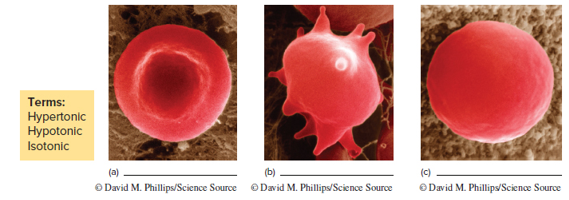
Connect with LearnSmart Labs for Lab Manual for Human Anatomy & Physiology
4th Edition
ISBN: 9781260159233
Author: Terry Martin, Cynthia Prentice-Craver
Publisher: Mcgraw-hill Higher Education (us)
expand_more
expand_more
format_list_bulleted
Concept explainers
Textbook Question
Chapter 6, Problem 3.5A
Observe the RBCs shown in figure 6.6. Select the solutions in which the cells were placed to the effects oftonicity on cells.
FIGURE 6.6 Three blood cells Placed in three different solutions: distilled water,

Expert Solution & Answer
Want to see the full answer?
Check out a sample textbook solution
Students have asked these similar questions
Different species or organisms research for ecology
What is the result of the following gram stain:
positive
○ capsulated
○ acid-fast
○ negative
What
type
of stain is the image below:
capsule stain
endospore stain
gram stain
negative stain
ASM MicrobeLibrary.org Keplinger
Chapter 6 Solutions
Connect with LearnSmart Labs for Lab Manual for Human Anatomy & Physiology
Ch. 6 - Which of the following membrane movements is not a...Ch. 6 - Osmosis is a membrane passage process pertaining...Ch. 6 - Which of the following represents an isotonic...Ch. 6 - Filtration requires ___________ for movements...Ch. 6 - Which of the following does not influence the rate...Ch. 6 - Dialysis tubing serves as a _________ for the...Ch. 6 - Passive membrane passage requires ATP. True...Ch. 6 - A cell will not swell or shrink when placed in an...Ch. 6 - Using a tea bag placed in hot water, explain due...Ch. 6 - By answering yes or no, indicate which of the...
Ch. 6 - By answering yes or no, which of the following...Ch. 6 - By answering yes or no, which of the following...Ch. 6 - Using what you know about the process of osmosis,...Ch. 6 - Prob. 2.1CTCh. 6 - Prob. 2.2CTCh. 6 - By answering yes or no, indicate which of the...Ch. 6 - Observe the RBCs shown in figure 6.6. Select the...Ch. 6 - Prob. 3.1CTCh. 6 - Prob. 4.2ACh. 6 - What force was responsible for the movement of...Ch. 6 - What substances did not pass through the filter...Ch. 6 - Prob. 4.5ACh. 6 - During exercise, skeletal muscles increase their...Ch. 6 - By answering yes or no, which of the following...Ch. 6 - By answering yes or no, which of the following...Ch. 6 - Prob. 4.3CT
Knowledge Booster
Learn more about
Need a deep-dive on the concept behind this application? Look no further. Learn more about this topic, biology and related others by exploring similar questions and additional content below.Similar questions
- What is the result of the acid-fast stain below: Stock Images by Getty Images by Getty Images by Getty Images by Getty Image Getty Images St Soy Getty Images by Getty Images by Getty Images Joy Getty encapsulated O endosporulating negative ○ positivearrow_forwardYou have a stock vial of diligence 75mg in 3ml and need to draw up a dose of 50mg for your patient.how many mls should you draw up to give this dosearrow_forwardYou are recquired to administer 150mg hydrocortisone intravenously,how many mls should you give?(stock =hydrocortisone 100mg in 2mls)arrow_forward
- If someone was working with a 50 MBq F-18 source, what would be the internal and external dose consequences?arrow_forwardWe will be starting a group project next week where you and your group will research and ultimately present on a current research article related to the biology of a pathogen that infects humans. The article could be about the pathogen itself, the disease process related to the pathogen, the immune response to the pathogen, vaccines or treatments that affect the pathogen, or other biology-related study about the pathogen. I recommend that you choose a pathogen that is currently interesting to researchers, so that you will be able to find plenty of articles about it. Avoid choosing a historical disease that no longer circulates. List 3 possible pathogens or diseases that you might want to do for your group project.arrow_forwardnot use ai pleasearrow_forward
- DNK dagi nukleotidlar va undan sintezlangan oqsildagi peptid boglar farqi 901 taga teng bo'lib undagi A jami H boglardan 6,5 marta kam bo'lsa DNK dagi jami H bog‘lar sonini topingarrow_forwardOne of the ways for a cell to generate ATP is through the oxidative phosphorylation. In oxidative phosphorylation 3 ATP are produced from every one NADH molecule. In respiration, every glucose molecule produces 10 NADH molecules. If a cell is growing on 5 glucose molecules, how much ATP can be produced using oxidative phosphorylation/aerobic respiration?arrow_forwardIf a cell is growing on 5 glucose molecules, how much ATP can be produced using oxidative phosphorylation/aerobic respiration?arrow_forward
arrow_back_ios
SEE MORE QUESTIONS
arrow_forward_ios
Recommended textbooks for you
 Human Physiology: From Cells to Systems (MindTap ...BiologyISBN:9781285866932Author:Lauralee SherwoodPublisher:Cengage Learning
Human Physiology: From Cells to Systems (MindTap ...BiologyISBN:9781285866932Author:Lauralee SherwoodPublisher:Cengage Learning



Human Physiology: From Cells to Systems (MindTap ...
Biology
ISBN:9781285866932
Author:Lauralee Sherwood
Publisher:Cengage Learning



Immune System and Immune Response Animation; Author: Medical Sciences Animations;https://www.youtube.com/watch?v=JDdbUBXPKc4;License: Standard YouTube License, CC-BY
Immune response: summary; Author: Dr Bhavsar Biology;https://www.youtube.com/watch?v=ADANgHkX4OY;License: Standard Youtube License